
PDF Publication Title:
Text from PDF Page: 008
Nanomaterials 2018, 8, 681 8 of 25 by AgNPs and the impressive interest oriented toward their application in wound therapy and medical-device coatings, their biocompatibility and safety aspects must be thoroughly clarified [187]. 7. Silver Nanoparticles for Bone Healing Every year, millions of people worldwide are affected by distinctive and complex bone-related pathologies, including infectious diseases, degenerative and genetic conditions, cancers, and fractures [188]. Unfortunately, the opportunistic contamination and colonization of orthopedic implants represent major concerns in osseous-tissue replacement strategies, since the related infections are associated with high morbidity [189]. Bone is an active tissue that undergoes regenerative and restorative processes through the intrinsic and complex bone-remodeling mechanism [190]. Bone grafts are usually implanted to replace or restore severe defects that irremediably affect osseous tissue, such as genetic malformations, tumors, or traumas [191]. Orthopedic and bone-implant-related infections are usually associated with highly inflammatory processes and subsequent implant loss and bone-destruction phenomena [192]. Previous studies reported that AgNPs naturally improve the differentiation process of MC3T3-1 pre-osteoblast cells and subsequent bone-like tissue mineralization, when compared with other NPs [193]. Currently, silver-coated prostheses represent an unconventional approach during the prophylaxis of tumor-related infections and extensive trauma-related infections. However, no clinical studies comparing the long-term clinical impact of nanosilver-coated implants for revision arthroplasty are reported as of yet [194]. The self-repairing capability of bone can be limited when bacterial activity occurs in bone defects. Compared with usual antibiotics, AgNPs possess intrinsic antibacterial activity with a broader spectrum. Also, the bacterial resistance to AgNP activity is an uncommon phenomenon, thus emphasizing that the bactericidal mechanisms of nanosilver act in synergy. Thanks to this peculiar property, AgNPs have the capability to inhibit or impair biofilm development or mature biofilm, respectively, in the case of antibiotic-resistant bacteria, such as methicillin-resistant Staphylococcus aureus [195]. Human bone, dentin, and dental enamel are mainly composed of crystallized hydroxyapatite (HA), which is a calcium-phosphate salt [196]. Given the specific biocompatibility of biosynthesized and synthetic HA, this material and its derivatives are extensively explored for the development of unconventional osseous-related restorative and regenerative strategies, either as artificial bone grafts or as coating materials for metallic implants [197]. With regards to the superficial modification of various metallic implant surfaces, biocompatible HA integrated with silver (either in metallic or ionic form) represents a suitable choice for the fabrication of bioactive and antimicrobial bone implants [198]. The antimicrobial efficiency of HA-based coatings embedded with nanosilver was evidenced against Gram-positive [199–201] and Gram-negative [202–204] bacterial strains. In terms of bone-replacement procedures, AgNPs are normally used as doping materials for synthetic and bio-inspired bone scaffolds, with relevant results being recently reported [205,206]. In order to induce antibacterial properties in HA coatings, several experimental techniques proved suitable for the incorporation of nanosilver within calcium-phosphate materials, such as laser-assisted deposition, electrochemical deposition, magnetron sputtering, ion-beam-assisted deposition, sol-gel technology, and microarc oxidation [207]. Previous studies showed that AgNP-implanted titanium displayed improved antibacterial ability, as well as excellent compatibility with osteoblasts, thanks to the micro-galvanic effects produced between the implanted AgNPs and the titanium substrate [208]. Many studies investigated the feasibility and clinical potential of adjusting acrylic cements with AgNPs, in order to provide unconventional and functionally improved biomaterials for orthopedic applications. While previous studies explored different acrylics modified with AgNPs, a significant part of the previous work is limited, since vital material characteristics and mechanical properties were not thoroughly analyzed [159,209–211].PDF Image | Biomedical Applications of Silver Nanoparticles

PDF Search Title:
Biomedical Applications of Silver NanoparticlesOriginal File Name Searched:
nanomaterials-08-00681-v2.pdfDIY PDF Search: Google It | Yahoo | Bing
Turbine and System Plans CAD CAM: Special for this month, any plans are $10,000 for complete Cad/Cam blueprints. License is for one build. Try before you buy a production license. More Info
Waste Heat Power Technology: Organic Rankine Cycle uses waste heat to make electricity, shaft horsepower and cooling. More Info
All Turbine and System Products: Infinity Turbine ORD systems, turbine generator sets, build plans and more to use your waste heat from 30C to 100C. More Info
CO2 Phase Change Demonstrator: CO2 goes supercritical at 30 C. This is a experimental platform which you can use to demonstrate phase change with low heat. Includes integration area for small CO2 turbine, static generator, and more. This can also be used for a GTL Gas to Liquids experimental platform. More Info
Introducing the Infinity Turbine Products Infinity Turbine develops and builds systems for making power from waste heat. It also is working on innovative strategies for storing, making, and deploying energy. More Info
Need Strategy? Use our Consulting and analyst services Infinity Turbine LLC is pleased to announce its consulting and analyst services. We have worked in the renewable energy industry as a researcher, developing sales and markets, along with may inventions and innovations. More Info
Made in USA with Global Energy Millennial Web Engine These pages were made with the Global Energy Web PDF Engine using Filemaker (Claris) software.
Infinity Turbine Developing Spinning Disc Reactor SDR or Spinning Disc Reactors reduce processing time for liquid production of Silver Nanoparticles.
| CONTACT TEL: 608-238-6001 Email: greg@infinityturbine.com | RSS | AMP |